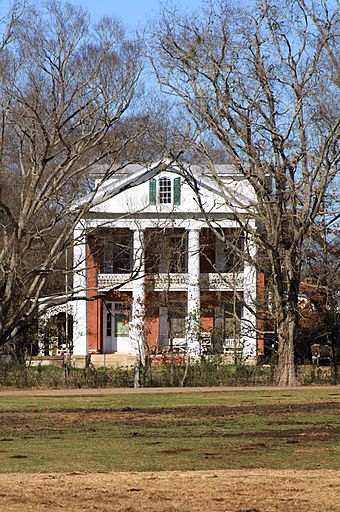Alfred Hatch Place at Arcola facts for kids
Quick facts for kids |
|
|
Alfred Hatch Place at Arcola
|
|

The plantation house in 2011
|
|
| Nearest city | Arcola, Alabama |
|---|---|
| Built | 1856 |
| Architect | Alfred Hatch |
| Architectural style | Greek Revival |
| NRHP reference No. | 87001784 |
| Added to NRHP | January 6, 1988 |
The Alfred Hatch Place at Arcola is a very old and important house in Alabama. It is also known as the Arcola Plantation. People in the area sometimes call it the Half-house. This historic plantation house and the land around it are located near the Black Warrior River in Alabama. It is a special place because of its history and unique design.
Discovering the Arcola Plantation
A Look Back: The Plantation's Story
The land where the Arcola Plantation stands was first settled by Frederic Ravesies. This area was once part of the Vine and Olive Colony. This colony was a town called Arcola. It was started by French immigrants in the early 1800s. The land was part of Marengo County until Hale County was created in 1867.
The main house was built in 1856. It was the center of a very large property, about 3,000 acres. This land was owned by Alfred Parker Hatch. He was born in North Carolina in 1799. Alfred Hatch moved to Alabama in 1840 with his family. He owned several large plantations. About 200 enslaved people were forced to work on his lands. He bought the Arcola property in the 1850s.
Alfred Hatch passed away in 1879. He left most of his property to his second wife. This caused some disagreements with the children from his first marriage.
The Unique Design of the Hatch Place
The Hatch Place is a rare example of a Greek Revival style house in Alabama. It looks like an ancient Greek temple. The house has three stories and is made of brick.
The front of the house has a large porch with four tall columns. This type of porch is called a portico. There is also a balcony on the second floor under the porch. Above the porch, in the triangular part of the roof called the pediment, there is a special window. It has a rounded, pointed shape known as a Tudor arch.
Because of its special design and history, the plantation was added to the National Register of Historic Places on January 6, 1988. This means it is recognized as an important historical site.



